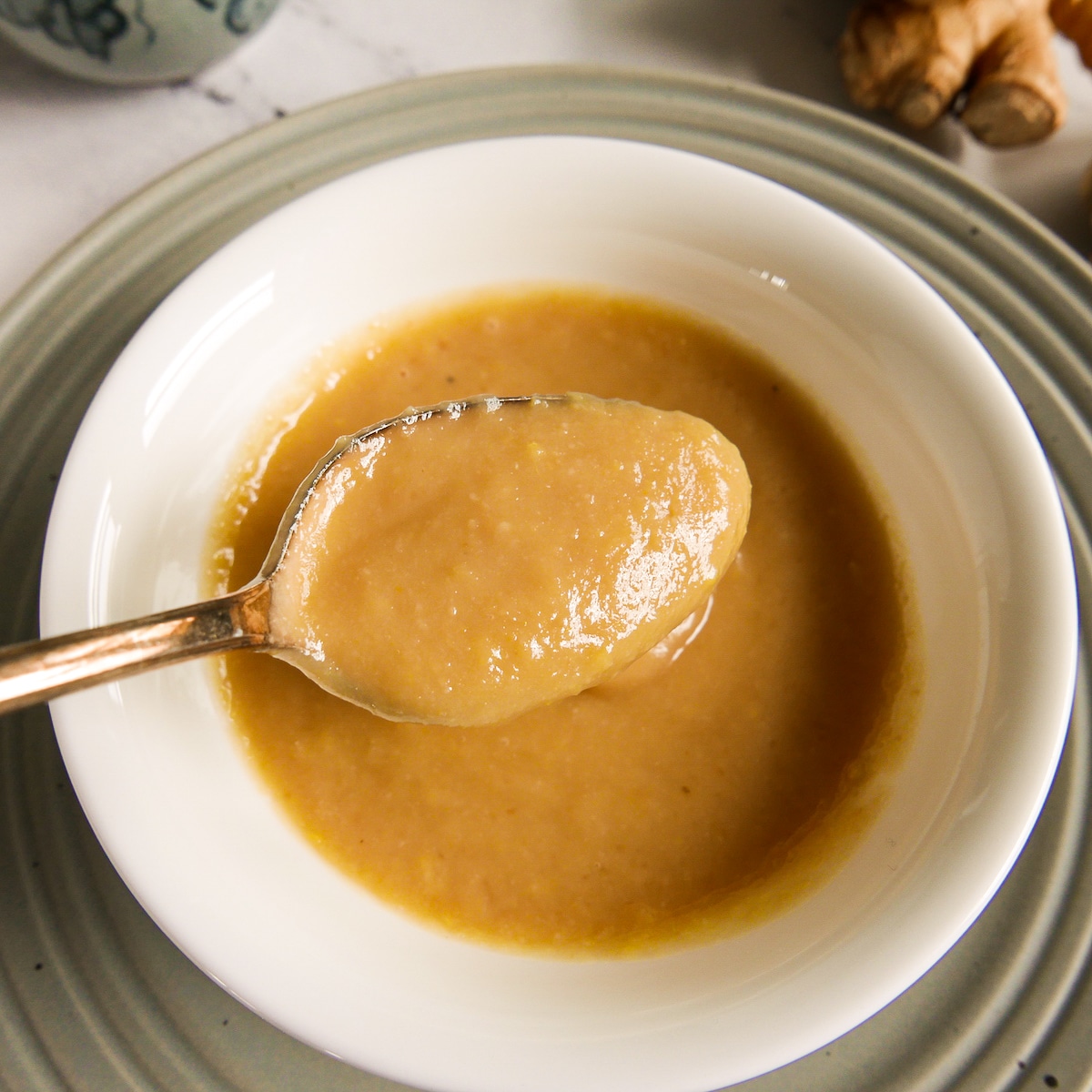This miso sauce is a versatile Japanese condiment full of rich umami flavor that's well-balanced with notes of savory, tangy, and sweet. Whether you're a fan of Japanese cuisine or simply looking to add bold flavor to your cooking, this versatile sauce will become your go-to condiment for rice, noodles, vegetables, or fish.

Want to save this recipe?
Enter your email below and get it sent straight to your inbox. Plus, I'll send you easy and delicious recipes every week!
In this homemade sauce, we create a harmonious blend with white miso, ginger, rice vinegar, sesame oil, and sugar.
All you need are 5 simple ingredients and you can whisk together this bold and savory condiment in just minutes. Believe me when I say you are going to want to pour it on everything!
Use miso sauce as a dressing, glaze, dipping sauce, or even as a marinade for your favorite protein. It's delicious on salmon or combined with noodles or rice. The possibilities are endless!
Jump to:
⭐️ Why This Sauce is the Best
- This all-purpose Japanese sauce adds so much robust umami flavor to a variety of dishes
- Quick and easy sauce that is whipped up in just 5 minutes
- Healthy fermented food, so it's a great source of probiotics; dairy-free & vegan; no preservatives or additives
- Better-tasting and cheaper than store-bought miso sauce
- A delicious versatile sauce that's great for rice, noodles, veggies, fish, and so much more.
🤔 What is Miso?

A staple in Japanese cuisine, miso is made from fermented soybeans and brings rich umami flavor (salty and funky!) to a variety of dishes. The paste is typically a mixture of soybeans, a grain (like rice or barley), koji, and salt.
Depending on the variety, miso can be light and sweeter (because of a shorter fermentation time) - which is usually sold as white miso - or dark red and much stronger in flavor, sold as red miso. We use the milder white miso for this recipe.
Miso is nutrient-rich and a good source of manganese and vitamin K. It's also a fermented condiment, which may improve digestion and gut health, and promote the growth of probiotics.
🥄 Ingredient Notes

- White miso paste - This is a milder-flavored fermented soybean paste, and it can usually be found in the refrigerated Asian foods section of your grocery store.
- Rice vinegar - Cuts through the richness of miso with a nice zippy tanginess.
- Fresh ginger - You can either grate your fresh ginger or give it a very fine dice. You can also use dried ginger in a pinch, but the ginger flavor won't be as fresh.
- Sesame oil - This provides deep umami and nutty flavor to our sauce. It can usually be found in the Asian section next to soy sauce in the supermarket.
- Granulated sugar - It might seem strange to add sugar to this sauce, but the sweetness is needed to balance out the salty and tangy savory flavors.
📝 Variations & Substitutions
- You can substitute white wine vinegar or lime juice for the rice vinegar for similar results.
- Gluten-free miso sauce: Check the ingredients of your miso paste to make sure that it's grain free (some brands are now made with gluten-free grains).

🔪 How to Make Miso Sauce
Add all of your ingredients into a small mixing bowl and whisk until well combined. Cover and refrigerate until ready to use. Keeps for about 3 weeks when stored in an airtight container in the refrigerator.

👩🏼🍳 Expert Tips
- Storage: Cover and store in the refrigerator for up to 3 weeks.
- How to freeze: This sauce freezes really well! Pour it into a freezer-safe container and store it for up to 3 months. To thaw, place it in the fridge overnight. Whisk it for a minute or so to re-emulsify it before serving.
- It gets better with age. Like a lot of sauces, this gets better as the days go by and the flavors mingle together. Make it a few days in advance to let the flavors meld together.
- Use white miso. As mentioned above, miso paste comes in a couple of different varieties. However, for this recipe, you should use white miso, which has a milder flavor.
- Choose the consistency. Your sauce will be fairly thin. However, you can make it even thinner by adding an additional tablespoon of water if you prefer. This will also dilute the flavor.
🍚 How to Use Miso Sauce

If I'm being honest, there isn't much that can't be made more delicious by adding miso dipping sauce. Here are some of my favorite ways to use this versatile Japanese sauce:
Use it as a dressing for rice, roasted vegetables, noodles, or salmon.
Serve it as a dipping sauce for your favorite proteins, like chicken, fish, or tofu. Or dip those sweet potato fries into it!
Use it as a marinade to infuse any protein with bold Japanese flavor. Marinating your protein for just 10 minutes will do the trick before sauteing, baking, or grilling.
💬 Frequently Asked Questions
Miso sauce is a traditional Japanese sauce. In this recipe, we combine white miso paste, fresh ginger, rice vinegar, sesame oil, water, and sugar for a well-balanced and deeply umami sauce.
While both products are made from fermented soybeans and aged for a certain period of time, miso is a paste that's typically made from rice or barley, and soy sauce is a liquid made from wheat. While they can often be used as a substitute for each other when cooking, they do have quite different and unique flavor profiles.
Miso is made from fermented soybeans, salt, koji, and a grain like rice or barley. It is turned into a thick paste that has been aged before being sold.
🍽 Related Posts
Tried this recipe? Please leave a star ⭐️⭐️⭐️⭐️⭐️ rating below and/or a review in the comments section further down the page. You can also stay in touch with us through social media by following us on Instagram, Pinterest, TikTok, and Facebook.
Subscribe to my email newsletter to get a FREE e-book of 20 vegetarian recipes, and get new recipes delivered to your inbox every week!

All-Purpose Miso Sauce Recipe (Glaze and Marinade)
Ingredients
- ¼ cup white miso paste
- 3 Tablespoons rice vinegar
- 1 teaspoon fresh ginger, grated
- 1 teaspoon sesame oil
- 1 Tablespoon granulated sugar
- 2 Tablespoons water
Instructions
- Add all of your ingredients into a small mixing bowl and whisk until well combined. Cover and refrigerate until ready to use.
- Keeps for about 3 weeks when stored in an airtight container in the refrigerator.
Video
Notes
- Storage: Cover and store in the refrigerator for up to 3 weeks.
- How to freeze: This sauce freezes really well! Pour it into a freezer-safe container and store it for up to 3 months. To thaw, place it in the fridge overnight. Whisk it for a minute or so to help re-emulsify it before serving.
- It gets better with age. Like a lot of sauces, this gets better as the days go by and the flavors mingle together. Make it a few days in advance to let the flavors meld together.
- Use white miso. As mentioned above, miso paste comes in a couple of different varieties. However, for this recipe, you should use white miso, which has a milder flavor.
- Choose the consistency. Your sauce will be fairly thin. However, you can make it even thinner by adding an additional tablespoon of water if you prefer. This will also dilute the flavor.









Leave a Reply